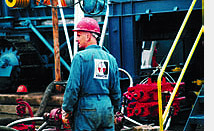Spheres within spheres
In the past, scientists tended to split the Earth System into ‘spheres’. But we have now reached the point where – having mentally taken the world apart – we must put it back together, to see how it actually works as a whole.To solve global environmental problems we need multidisciplinary research. To take just one pressing example; we cannot work out a global budget for ‘greenhouse’ gases in the atmosphere without considering the solubility of those gases in water (hydrosphere), the carbon dioxide locked up in the wood of the world’s great forests (biosphere), in the soil (pedosphere), or those rocks in the ‘geosphere’ that bind carbon in deposits of limestone, coal, oil, gas, or methane hydrate. Nor can we ignore volcanoes, which also produce huge quantities of natural greenhouse gases.
Nor, indeed, can we simply stop burning fuel. A world power shortage would have human consequences as terrible as runaway global warming. For Earth scientists, understanding those ‘carbon sinks’ is also vital to finding the resources that all countries desperately need to help their people towards a better life. Burning fossil carbon has powered the progress of civilisation and improved the living standards of humanity immeasurably – but only by incurring environmental costs that are unsustainable in the long term.
Earth sciences are in the forefront of detecting these changes, and finding ways of mitigating them before it is too late. For example, experiments are now under way to turn polluting coal – which contributes to global warming if burned – into pure hydrogen, without even removing it from the ground. Other research may pave the way for large quantities of waste carbon dioxide to be re-injected into the rocks from where the fuel originally came.
 |
In Poland, greenhouse gas extracted from the atmosphere is safely sequestered in the geosphere by being injected into coalbeds 1 km below the surface in a pioneering experiment. |
| Planet Earth in our hands |
|||
| The changing world of Earth Science |
|||
| Humans in the landscape |
|||
| Building high, building deep |
|||
| Earth sciences for development Earth science is essential to understanding this complex,balanced Earth System on which we all depend.But it is all too easy to take the Earth’s resources for granted. All civilisations depend on supplies of energy and raw materials. To take an example from humanity’s oldest continuous civilisation, in North China,as early as 6000BC, ‘salt wars’ were fought over Lake Yuncheng. Five thousand years later the Chinese began using iron. Due to taxes on salt and iron (both state monopolies) the Chinese were able to create a great empire that, around 100 BC, was larger and more advanced than that of the Romans. Three hundred years later, the Chinese people succeeded in piping gas from those mines to their stoves, using bamboo – the first known use of natural gas. |
|||